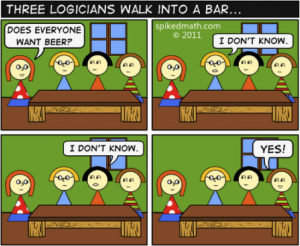A Common Joke About Common Knowledge

If you enjoy this joke (which is discussed here, and comes from the folks at Spiked Math Comics) as much as I do, you might be a gearhead.
It illustrates one of the many surprising and subtle impacts of common knowledge. Yale’s John Geanakoplos provides an even more perverse version of the bar cartoon, in this incredibly helpful chapter :
Imagine three girls sitting in a circle, each wearing either a red hat or a white hat. Suppose that all the hats are red. When the teacher asks if any student can identify the color of her own hat, the answer is always negative, since nobody can see her own hat. But if the teacher happens to remark that there is at least one red hat in the room, a fact which is well-known to every child (who can see two red hats in the room) then the answers change. The first student who is asked cannot tell, nor can the second. But the third will be able to answer with confidence that she is indeed wearing a red hat.
You can find out the reasoning behind the inference here.
Back in 1997, Barry Nalebuff and I published an article showing how the common knowledge about insulting or threatening bits of information can destroy relationships and thereby be a “barrier to negotiation.” The beginning of the article lays out a simple description of the double infinity of knowledge that constitutes common knowledge:
When we communicate one thing, we often unavoidably send other messages. To start with a simple example, imagine that Ian says to Barry, “My mother’s name is Karen.” From Ian’s communication, Barry learns more than just the underlying bit of information (mom’s name). The communication also lets Barry know that: (a) Ian knows his mom’s name, and (b) Ian knows that Barry knows Ian’s mom’s name.
What is less well understood is that when we teach, we learn. When Ian tells Barry about his mom, Ian learns several things. For example, by telling Barry, Ian now knows that Barry knows Karen is the name of Ian’s mom. Direct communication of a fact can potentially create two infinite series of knowledge. If we symbolize the underlying bit of information (Karen is Ian’s mom) as K, then Ian’s communication might create the following hierarchy of beliefs:
| Table 1: Potential Hierarchy of Beliefs | |
| Ian’s Knowledge | Barry’s Knowledge |
| 1a. Ian knows K | 1b. Barry knows K |
| 2a. Ian knows Barry knows K | 2b. Barry knows Ian knows K |
| 3a. Ian knows that Barry knows that Ian knows K | 3b. Barry knows that Ian knows that Barry knows K |
| and so on . . . | and so on . . . |
If Ian’s communication succeeds in creating both of these infinite series, economists would say that the underlying fact is “common knowledge.” Table 1 makes clear how directly communicating a simple fact can produce other types of knowledge. Ian begins with what we will call “first-order” information (la) and wants to convey this to Barry (1b). But in doing so, Ian may be teaching Barry “higher-order” information as well (2b, 3b, 4b, etc.). Moreover, by teaching Barry, Ian may unavoidably acquire higher-order information himself (2a, 3a, 4a, etc.).
[HT: Peter Siegelman]

Comments